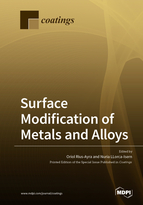Surface Modification of Metals and Alloys
A special issue of Coatings (ISSN 2079-6412). This special issue belongs to the section "Surface Characterization, Deposition and Modification".
Deadline for manuscript submissions: closed (31 December 2023) | Viewed by 13436
Special Issue Editors
Interests: alloys; surface modification technology; nanomaterials and nanotechnology; powder metallurgy; functionalized materials surfaces; sustainability; characterization; severe plastic deformation
Interests: materials surface modification; functionalized materials surface; superhydrophobicity; superwettability; oil-in-water separation; sustainability; nanomaterials and nanotechnology; ball-milling; characterization
Special Issues, Collections and Topics in MDPI journals
Special Issue Information
Dear Colleagues,
For various reasons, it has become necessary for us to find an alloy with a different surface behavior from that of the bulk: a greater or more specific to extreme environments resistance to corrosion and to wear, higher mechanical or fatigue resistance, hydrophobicity, oleophilicity, thermal (for low or high temperature exposure), magnetic, electrical or specific optic or light exposure behavior or to create biocompatibility or (bio)fouling or even their combined effect. To have these properties in metals and alloys, we must apply the strategy of surface modification based on a direct action on the metal or incorporating a coating that will provide these properties or functionalize its surface for complex requirements.
This Special Issue on Surface Modification of Metals and Alloys concerns the many different and innovative approaches that can be used to transform the metallic surface by means of physical, chemical, mechanical or biological characteristics providing different properties from the ones originally found on these surfaces allowing functionality for a given application.
In general, the topics of interest range from newer approaches of conventional coatings technologies and thermomechanical processes, biocoatings, and surface modification for energy applications, catalysis, and nanomaterials to functionalization of metallic powder and additive manufactured metallic surfaces. All these improvements will be focused on developing successful engineering products and parts; some new strategies will also contribute to solving environmental issues.
In particular, the topics of interest are:
- Characterization of engineered surfaces (tribological, corrosion, morphology, structure, composition);
- Treatments covering the surface of metals and alloys:
- Conversion coatings;
- Spraying processes;
- Deposition processes;
- Treatments altering the surface of metals and alloys:
- Mechanical and thermomechanical processes;
- Laser-beam-based technologies;
- Diffusion processes;
- Special processes;
- Functional and multifunctional coatings and films;
- Novel surface modification techniques;
- Additive manufactured surfaces.
Prof. Nuria Llorca-Isern
Dr. Oriol Rius-Ayra
Guest Editors
Manuscript Submission Information
Manuscripts should be submitted online at www.mdpi.com by registering and logging in to this website. Once you are registered, click here to go to the submission form. Manuscripts can be submitted until the deadline. All submissions that pass pre-check are peer-reviewed. Accepted papers will be published continuously in the journal (as soon as accepted) and will be listed together on the special issue website. Research articles, review articles as well as short communications are invited. For planned papers, a title and short abstract (about 100 words) can be sent to the Editorial Office for announcement on this website.
Submitted manuscripts should not have been published previously, nor be under consideration for publication elsewhere (except conference proceedings papers). All manuscripts are thoroughly refereed through a single-blind peer-review process. A guide for authors and other relevant information for submission of manuscripts is available on the Instructions for Authors page. Coatings is an international peer-reviewed open access monthly journal published by MDPI.
Please visit the Instructions for Authors page before submitting a manuscript. The Article Processing Charge (APC) for publication in this open access journal is 2600 CHF (Swiss Francs). Submitted papers should be well formatted and use good English. Authors may use MDPI's English editing service prior to publication or during author revisions.






